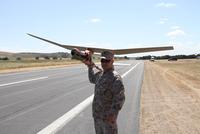-
Reason-based behavioral recognition system wins award
A reason-based behavioral recognition system for video surveillance developed by Houston, Texas-based BRS Labs wins an award at London’s Counter Terror Expo
-
-
Seattle police takes steps to quell drone concerns
The Seattle Police Department recently acquired a small camera-equipped drone, but it remains unused while city policymakers work to calm privacy concerns
-
-
Kansas City to deploy ShotSpotter technology
Kansas City police and the Kansas City Area Transportation Authority have agreed jointly to deploy the Shot Spotter, an acoustic technology that provides detailed information on gunshots fired
-
-
Maryland police defy court decision, continue to collect arrestees DNA
Police departments around Maryland will continue to collect arrestees DNA despite the state top court’s ruling by a five-to-two decision that such collection is a violation of Fourth Amendment rights to privacy
-
-
Report: Some terrorist plots hatched by FBI
In recent years a number of terrorist attacks against the United States have been foiled by federal, state, and local authorities; a number of these plots may have been initiated by the FBI, and though they fall short of entrapment, they may well never have been developed without the FBI’s direct encouragement
-
-
German official: Lone-wolf terrorists are the greatest threat
Germany’s interior minister said that the greatest terrorist threat Germany faces is no longer the large-scale organization of the al Qaeda stripe, but the independent “lone-wolf” attacker
-
-
U.S. military seeking non-lethal UAVs

The U.S. Army is seeking non-lethal warheads to be deployed on tiny UAVs; the U.S. Army describes the possible uses of the non-lethal UAV: “Potential commercial applications might include, but are not limited to: crowd control for local law enforcement; border protection for Homeland Security; or temporary incapacitation of non violent criminals for local SWAT teams and/or law enforcement”
-
-
First U.S. drone attack in Pakistan in a month kills four terrorists
Yesterday, Sunday, missiles launched from a CIA drone missiles hit military targets in Pakistan for the first time in a month. The attack killed four al Qaeda members, but further heightening tensions between the United States and Pakistan. Back in November 2011, U.S. airstrikes, called in by Pakistani commanders n the ground, killed twenty-four Pakistani soldiers. In response, Pakistan said that unless the United States apologized for the incident, no more U.S. drone attack would be allowed against terror targets inside Pakistan. The United States expressed regrets over the death of the soldiers, but refused to apologize, saying the accident was the result of mistakes and miscommunication on both sides. Since November, the United States has reduced considerably the number of drone attacks inside Pakistan, but has refused to end such attacks altogether. The U.S. refusal has led to Pakistani parliament, on three different occasions, to pass resolutions calling upon the United States to cease and desist.
-
-
Surface-to-air missiles to protect London Olympic Games
British security sources revealed that the security envelope developed to protect the Summer Olympic Games in London will include six Rapier surface-to-air missile (SAM) batteries. The British security forces will conduct, between 2 and 10 May, a massive exercise, called Exercise Olympic Guardian, on land, sea, and in the air in the London and Weymouth areas. For those familiar with London: For the exercise, six sites were selected for deployment of the SAM dummies: the Lexington Building in Tower Hamlets; the Fred Wigg Tower in Waltham Forest, east London; Blackheath Common; Oxleas Wood, Eltham; William Girling Reservoir, Enfield; and Barn Hill in Epping Forest.
-
-
NATO prepares for a new, futuristic war
NATO’s Operation Locked Shields, an international military exercise the military alliance conducted last month, was different from trasditional war games. There were no bullets, tanks, aircraft, ships, or camouflage face-paint. The troops involved in the exercise spent most of their time in air-conditioned rooms within a high security military base in Estonia. The exercise, a window into what a future war would look like, had one team of IT specialists detailed to attack nine other teams, located in different parts of Europe. The IT experts, working from their terminals in the Nato Co-operative Cyber Defense Center of Excellence, created viruses, worms, Trojan Horses, and other Internet attacks, aiming to hijack and extract data from the computers of their “enemies.”
-
-
Two Taiwanese nationals charged in military technology smuggling plot

Taiwanese nationals engaged in smuggling counterfeit consumer goods and crystal methamphetamine into the United States, are discovered to be working for Chinese intelligence agencies in an effort to smuggle sensitive U.S. military technology out of the United States
-
-
Critics slam administration’s “minor offenses” deportation stance
Critics if the administration’s immigration policies slam the administration’s last week announcement that it will no longer initiate enforcement actions against deportable aliens identified by the Secure Communities program who have committed minor criminal offenses
-
-
Oklahoma University gets DHS research grant
The University of Oklahoma Health Sciences Center (OUHSC) was awarded a $490,000 grant from DHS for a 2-year study of how law enforcement officers utilize awareness of their surroundings to collect and then analyze intelligence related to potential terrorist threats
-
-
LAPD shows the way in local counterror efforts

Commander Joan T. McNamara, who heads the LAPD Counter-Terrorism and Criminal Intelligence Bureau, has devised a method which is considered so inexpensive, easily implemented, and innovative that federal authorities are considering making it a national model for local law enforcement intelligence gathering
-
-
Supreme Court hears arguments on Arizona immigration law
The U.S. Supreme Court yesterday heard arguments about the tough Arizona immigration law, known as SB107; the case highlights a fundamental disagreements over the precise balance of power between the states and the national government; the judges appeared skeptical of the administration’s arguments; the Arizona case may occasion a redrawing by the Supreme Court of established boundaries between the federal government and the states on immigration enforcement
-
More headlines
The long view
Tantalizing Method to Study Cyberdeterrence
Tantalus is unlike most war games because it is experimental instead of experiential — the immersive game differs by overlapping scientific rigor and quantitative assessment methods with the experimental sciences, and experimental war gaming provides insightful data for real-world cyberattacks.
Using Drone Swarms to Fight Forest Fires
Forest fires are becoming increasingly catastrophic across the world, accelerated by climate change. Researchers are using multiple swarms of drones to tackle natural disasters like forest fires.
Testing Cutting-Edge Counter-Drone Technology
Drones have many positive applications, bad actors can use them for nefarious purposes. Two recent field demonstrations brought government, academia, and industry together to evaluate innovative counter-unmanned aircraft systems.
European Arms Imports Nearly Double, U.S. and French Exports Rise, and Russian Exports Fall Sharply
States in Europe almost doubled their imports of major arms (+94 per cent) between 2014–18 and 2019–23. The United States increased its arms exports by 17 per cent between 2014–18 and 2019–23, while Russia’s arms exports halved. Russia was for the first time the third largest arms exporter, falling just behind France.
How Climate Change Will Affect Conflict and U.S. Military Operations
“People talk about climate change as a threat multiplier,” said Karen Sudkamp, an associate director of the Infrastructure, Immigration, and Security Operations Program within the RAND Homeland Security Research Division. “But at what point do we need to start talking about the threat multiplier actually becoming a significant threat all its own?”
The Tech Apocalypse Panic is Driven by AI Boosters, Military Tacticians, and Movies
From popular films like a War Games or The Terminator to a U.S. State Department-commissioned report on the security risk of weaponized AI, there has been a tremendous amount of hand wringing and nervousness about how so-called artificial intelligence might end up destroying the world. There is one easy way to avoid a lot of this and prevent a self-inflicted doomsday: don’t give computers the capability to launch devastating weapons.
